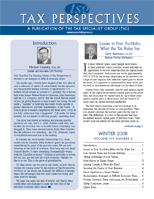
PDF Format
 Issue Contents Issue Contents
 All Issues All Issues
Winter 2008
Volume 8, Number 2
The information in Tax Perspectives is prepared for general interest only. Every effort has been made to ensure that the contents are accurate. However, professional advice should always be obtained before acting and TSG member firms cannot assume any liability for persons who act on the basis of information contained herein without professional advice.
Low Interest Rates and Income Splitting
By Grace Chow, CA, TEP
Cadesky and Associates LLP (Toronto)
With interest rates at historical lows, opportunities now abound for income splitting.
If property is transferred to a spouse or minor children, any income earned from the property (and, in the case of a spouse, any gains from the sale of the property) are attributed to, and taxed in the hands of, the person who transferred the property. This rule, and other related provisions, are designed to stop income splitting between family members. The rule applies to direct transfers, and to indirect transfers through trusts. However, if the transfer is made by way of a loan, and interest is paid on the loan at the “prescribed rate” of interest, attribution does not apply.
The prescribed rate of interest is set each quarter, based on the average treasury bill yield, rounded up to the nearest integer. If the Treasury bill yield was say 2.88%, the prescribed rate would be 3%.
In this marketplace, if one believes that there is good potential for gains over the longer term, a strategy can be developed to split income with a lower income spouse or with minor children. This would involve a transfer of cash or investments to the spouse (or a trust for the children), in exchange for a promissory note paying interest at the prescribed rate (say 3%). Interest must be paid within 30 days of the end of the calendar year, or income attribution will apply.
While the higher income spouse will include the inter-family interest income on his or her tax return and pay tax on it, the lower income spouse (or the trust) will obtain a tax deduction. More importantly, any income earned on the property transferred, including capital gains, will not be subject to income attribution, and will be reported by the lower income spouse (or the trust). This could offer a very significant benefit.
In addition, it is possible to “have your cake and eat it” when income splitting with a spouse. If gains are realized, interest will be paid 30 days after the year-end, as required, so that income attribution will not apply. On the other hand, if losses result, deliberate failure to pay interest will cause the losses to be attributed back to the higher income spouse.
This simple but effective strategy can potentially yield significant tax savings.
|